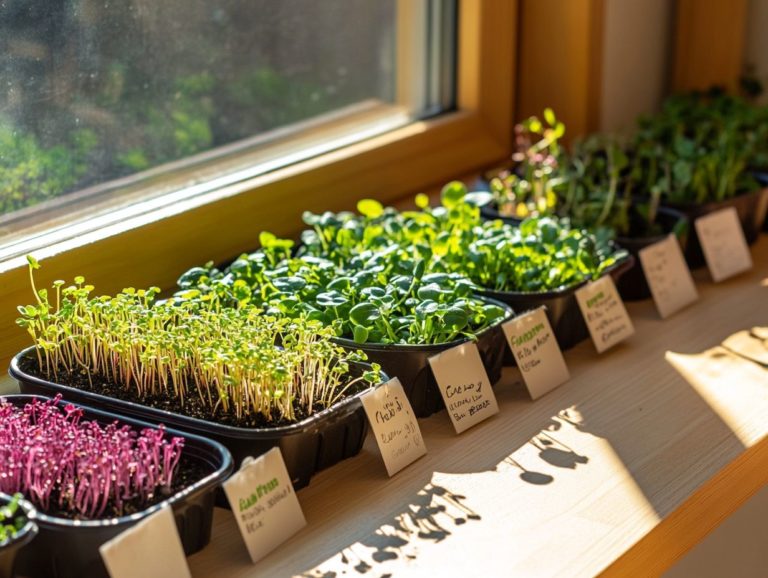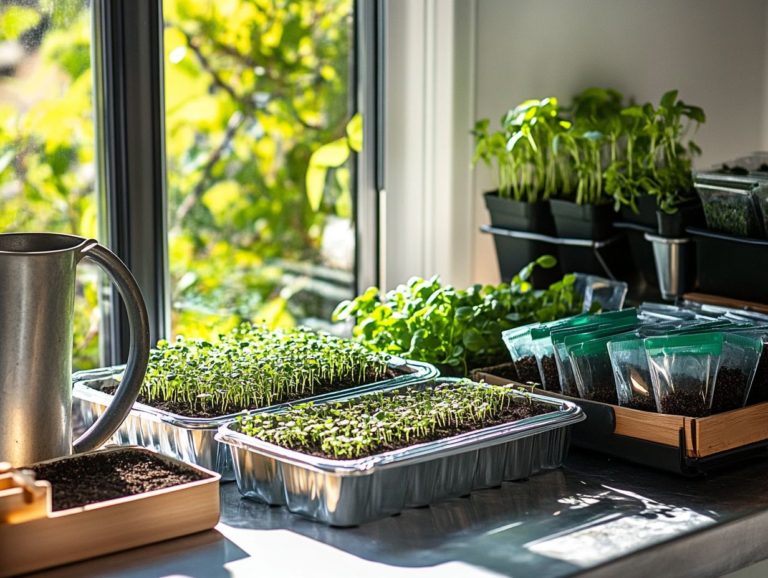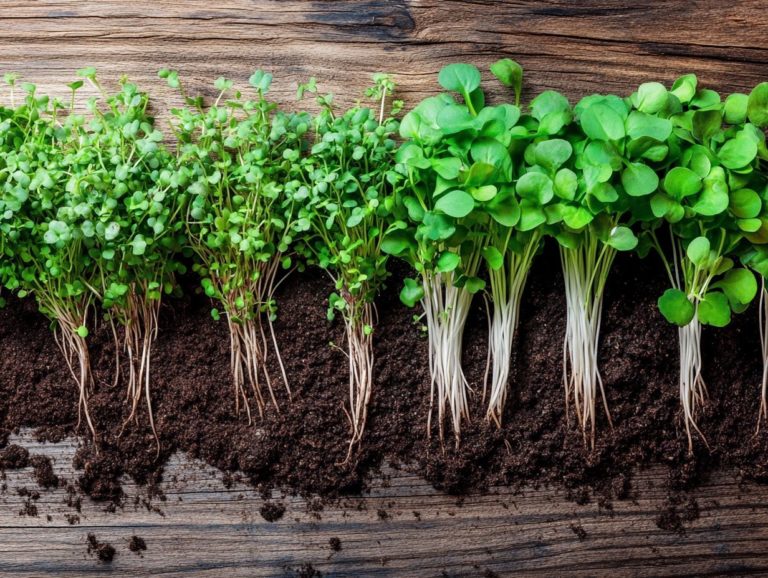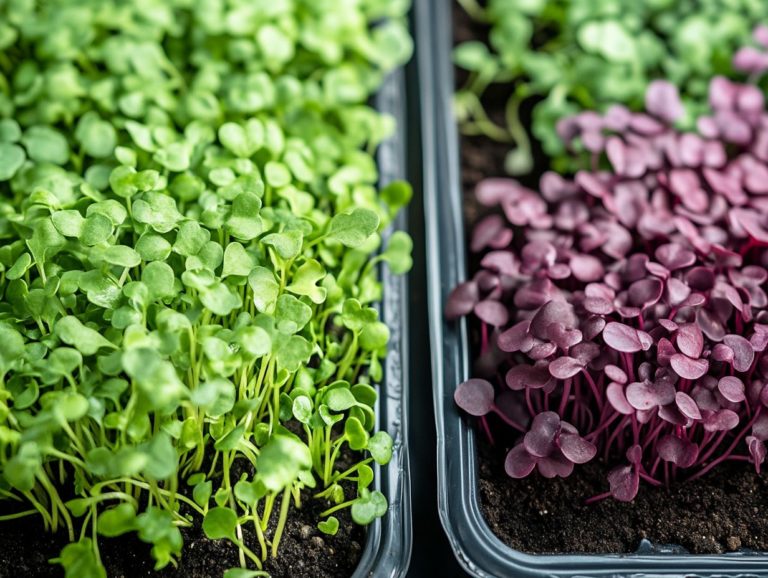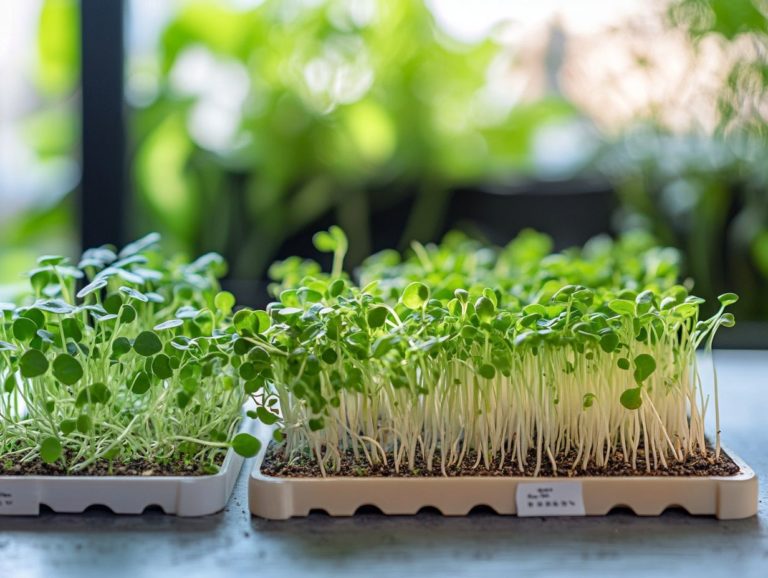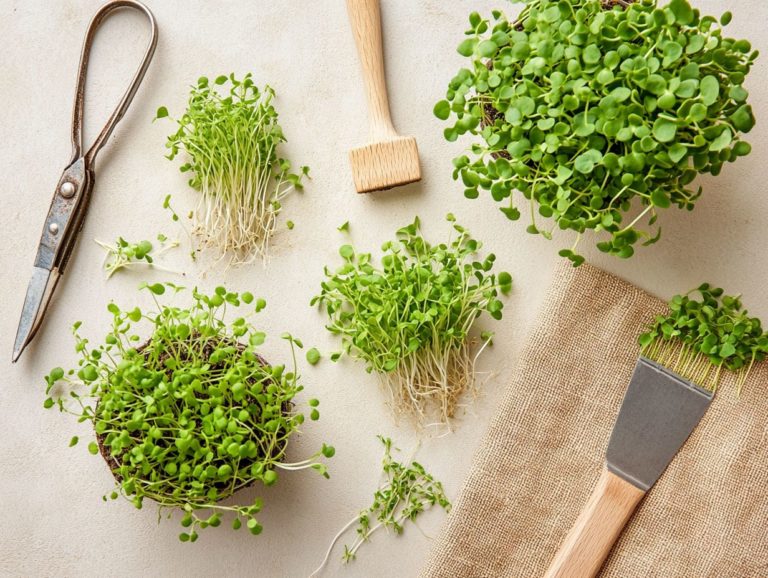5 Key Factors for Successful Microgreen Growing
Microgreens have truly revolutionized the culinary landscape, delivering an explosion of flavor and nutrition in delightfully compact forms. They have become popular in the realm of food production.
Whether you re a seasoned gardener or just starting to dip your toes into the world of plants, cultivating these tiny greens at home can be fulfilling and enjoyable. This is especially true in the context of home gardening.
You ll delve into five essential factors for successful microgreen cultivation. We ll cover everything from choosing the right seeds to timing your harvest just right, ensuring you understand the importance of optimal harvest time.
Along the way, you ll uncover various types of microgreens, their great nutrition, and expert tips to maximize your yield.
Get ready to turn your kitchen into a lively mini-garden and impress your taste buds like never before!
Contents
- Key Takeaways:
- 1. Choosing the Right Seeds
- 2. Providing Adequate Lighting
- 3. Proper Watering Techniques
- 4. Maintaining Optimal Temperature and Humidity
- 5. Harvesting at the Right Time
- What Are Microgreens and Why Are They Popular?
- Frequently Asked Questions
- What are the five key factors for growing microgreens?
- How much light do microgreens need to grow successfully?
- What is the ideal water schedule for microgreens?
- What temperature range is best for microgreen growth?
- Why is soil important for successful microgreen growth?
- How do you choose the right variety of microgreens to grow?
Key Takeaways:
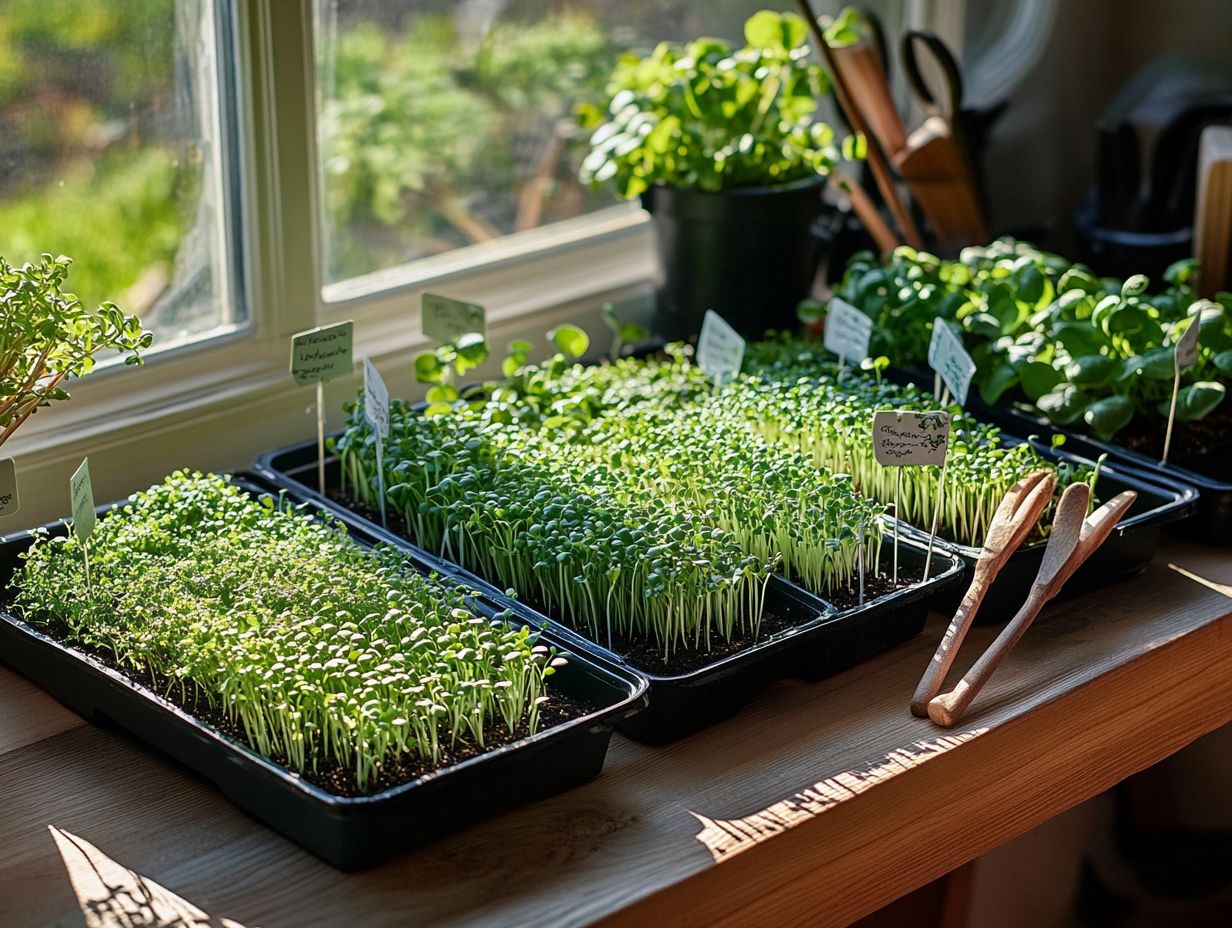
- Choose high-quality organic seeds for optimal growth and flavor.
- Provide sufficient lighting, both natural sunlight and artificial lighting.
- Practice proper watering techniques using tools like a spray bottle and watering trays.
1. Choosing the Right Seeds
Choosing the right seeds is essential for home gardening. This is especially true for cultivating microgreens.
Varieties like Pea shoots and Brassica seeds can elevate your culinary creations while adding a fresh touch to your vegetable diet. Each species has specific growing conditions.
If you’re considering Sunflower microgreens, they love warm temperatures and lots of sunlight. In contrast, Radish microgreens are speedy friends that grow quickly and tolerate cooler conditions with ease.
Using organic seeds promotes healthier crops and guarantees your microgreens are free from harmful chemicals. For instance, Mustard greens deliver a zesty kick, while Broccoli microgreens are abundant in cancer-fighting compounds.
For sourcing your seeds, seek reliable stores or trusted online retailers that specialize in organic gardening supplies. This ensures the quality and viability of your seeds, setting the stage for a thriving garden.
2. Providing Adequate Lighting
Good lighting is the secret sauce for healthy microgreens! It significantly influences their development, flavor, and nutrient content.
To create optimal growing conditions, strike a balance between natural sunlight and artificial lighting when necessary. Understanding the types of lighting available, such as LED and fluorescent options, can enhance your indoor gardening experience.
LEDs are energy-efficient and emit specific wavelengths that encourage vigorous growth. Meanwhile, fluorescent lights are a budget-friendly alternative, perfect for beginners.
Consider the light exposure required during various growth stages. Seedlings thrive on about 12 to 16 hours of light each day, while mature plants may require less. You may need to adjust your lighting as the seasons change.
Tailoring your light management to meet each microgreen s unique needs will maximize yield and ensure the best flavor profiles.
3. Proper Watering Techniques
Watering correctly is crucial for germinating microgreens. Keeping the right soil moisture helps prevent both overwatering and underwatering, which can hinder growth.
Using tools like spray bottles and watering trays improves your watering efficiency. These allow for a gentle mist or even distribution of water, promoting healthy moisture levels without disturbing seedlings.
During germination, check moisture by pressing your finger into the soil. If it feels dry an inch below the surface, it s time to water.
Young plants need frequent misting. As they mature, reduce watering frequency and increase water volume to strengthen roots.
4. Maintaining Optimal Temperature and Humidity
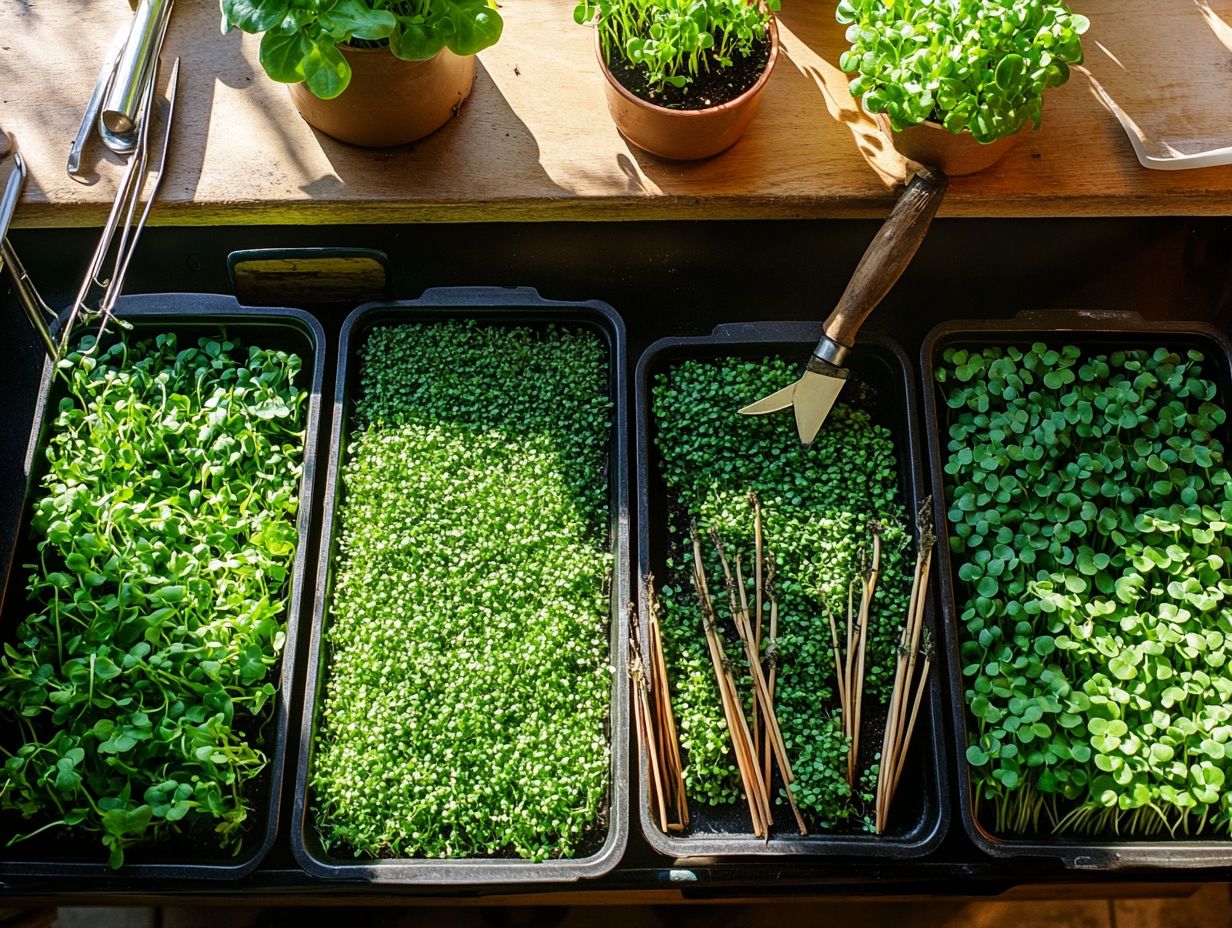
Keeping the right temperature and humidity is vital for microgreens’ growth. These factors directly impact plant health and nutrient availability.
Different microgreens thrive at specific temperatures, usually between 60 F to 75 F (15 C to 24 C). For example, basil prefers warmer conditions, while leafy greens like lettuce can tolerate cooler temperatures.
Target humidity levels of 40-60% to prevent mold and diseases. It s helpful to use hygrometers and thermometers to monitor conditions.
If temperatures drop too low, a space heater can help. Fans can boost airflow and regulate humidity.
If you live in a dry area, consider using a humidifier to create an ideal environment for your microgreens.
5. Harvesting at the Right Time
Harvesting at the right moment ensures you enjoy the full flavor and nutritional benefits of your microgreens. Each species has its timeline and technique, affecting taste and texture.
Learn when to harvest; waiting too long can lead to bitterness, while harvesting too early means missing out on nutrients. Most microgreens are ready when they reach 1 to 3 inches tall, showing vibrant colors and robust leaves.
Use scissors to cut just above the soil line or gently pull them out by the roots to minimize damage to remaining plants.
Store harvested microgreens in a cool, dark place. Wrapping them in a damp paper towel and placing them in a sealed container in the fridge will keep them fresh.
What Are Microgreens and Why Are They Popular?
Microgreens are young, edible greens harvested at their peak growth. They’re popular for their impressive health benefits, high nutritional value, and versatility in cooking.
These tiny powerhouses include species like arugula, basil, and radish, packed with vitamins and antioxidants. Their popularity reflects a shift towards healthy eating and plant-based diets, providing concentrated nutrients in a small size.
Incorporate microgreens into your meals by sprinkling them on salads, blending them into smoothies, or adding them to sandwiches. This boosts your vegetable intake while offering exciting culinary experiences.
What Are the Different Types of Microgreens?
You ll discover a world of microgreen species, each bringing its own unique flavors, textures, and nutritional benefits to the table. Among the most popular choices are Pea shoots, Mustard microgreens, and Broccoli, each adding a distinct culinary flair to your dishes.
Pea shoots are celebrated for their sweet, tender taste, making them a fantastic addition to salads and sandwiches. Mustard microgreens deliver a spicy kick, perfect for elevating stir-fries or serving as a zesty garnish.
Broccoli microgreens are prized for their mild flavor and favored by health enthusiasts for their cancer-fighting properties.
These delightful greens thrive in well-drained soil and bask in ample sunlight, typically ready for you to harvest within just two weeks. For optimal growth, understanding the perfect light conditions for microgreens is essential. Beyond enhancing your meals, microgreens are packed with vitamins A, C, E, and K, offering impressive anti-inflammatory and antioxidant benefits that contribute significantly to your overall well-being.
What Are the Nutritional Benefits of Microgreens?
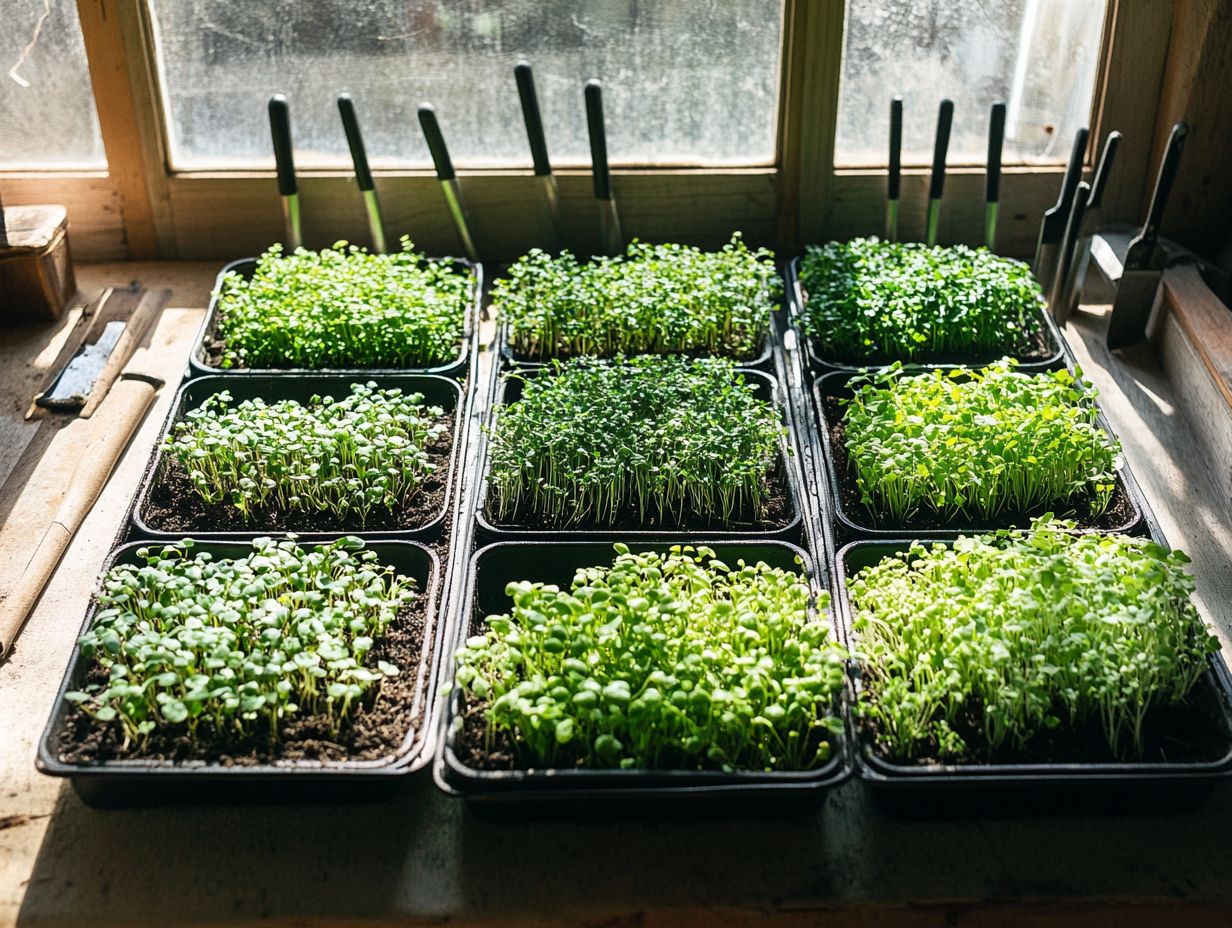
Microgreens are truly a marvel in the cooking world, renowned for their exceptional nutritional value. They often boast higher levels of essential minerals and vitamins than their mature counterparts, making them a critical addition to any health-conscious diet.
Tiny greens like arugula and radish sprouts pack in nutrients. They offer vitamin C, vitamin E, and strong antioxidants. By including microgreens in your daily meals, you not only enhance flavor but also elevate your overall well-being.
For example, a handful of beet microgreens can significantly boost your iron intake, while broccoli microgreens may provide remarkable cancer-fighting properties.
Add these greens to your smoothies, sandwiches, or use them as a garnish. They’ll boost your nutrient intake effortlessly. It makes adhering to dietary guidelines aimed at promoting health and longevity all the more achievable.
What Are the Common Pests and Diseases in Microgreens?
Common pests and diseases can significantly threaten your microgreens, affecting their growth and your gardening success. You need to be vigilant and manage your plants carefully.
You might notice issues manifesting as wilting leaves, discolored stems, or even an unexpected invasion of insects on the soil surface. Aphids and fungus gnats, for example, can be particularly troublesome, leading to stunted growth and the spread of disease.
To tackle these challenges, regularly inspect your crops for early signs of infestations or infections. Keep humidity levels right and ensure good air circulation to deter pests.
Consider utilizing organic solutions such as neem oil or insecticidal soaps, or even introducing beneficial insects like ladybugs, which help control pests naturally. Additionally, to enhance your growing techniques, check out these 5 tips for successful microgreen germination. These methods not only protect your microgreens but also foster a sustainable growing environment.
How Can One Start Growing Microgreens at Home?
Growing microgreens at home is easy and rewarding. You’ll love adding fresh greens to your meals! This endeavor requires minimal space and equipment, making it a perfect choice for both aspiring gardeners and seasoned enthusiasts.
With just a few straightforward steps, you can embark on this enriching experience. Start by selecting the right container; shallow trays, recycled plastic containers, or even egg cartons serve beautifully for these tiny plants. To learn more about getting the most out of your efforts, check out this guide on how to maximize yields from microgreens.
Next, it’s vital to choose the appropriate soil or compost, as an excellent organic mix will facilitate optimal growth and nutrient absorption. To get started, learn how to choose the right soil for microgreen growth. Don’t overlook the essentials: gather a spray bottle for gentle watering, scissors for harvesting, and labels to keep track of your various microgreen varieties.
Easy to cultivate, microgreens not only add a delightful crunch to your meals but also deliver a powerful nutritional punch, encouraging you to embrace healthier eating habits.
What Are Some Tips for Maximizing Yield and Flavor in Microgreens?
Maximizing yield and flavor in microgreens requires a thoughtful approach that encompasses light management, best soil or growing material, and precise watering techniques. This approach should be tailored to the unique needs of the microgreen species you re cultivating.
Balancing these elements creates a thriving environment. This promotes robust growth. For example, ensuring your greens receive adequate light exposure, typically between 12 to 16 hours a day, will make your greens pop with color and pack in nutrients! However, be mindful of the top 5 mistakes in growing microgreens that can hinder their development.
Selecting the right growing material, whether it be soil or special mats used to grow plants without soil, will greatly influence root development and moisture retention. This ultimately affects the overall success of your food production. For more insights, check out these essential tips for growing microgreens at home.
Adjusting your watering practices, like opting for a misting spray instead of flooding, helps prevent mold while encouraging healthy, flavorful plants. These strategies improve crop viability and enhance the taste profile, making your microgreens even more enjoyable to consume.
Frequently Asked Questions
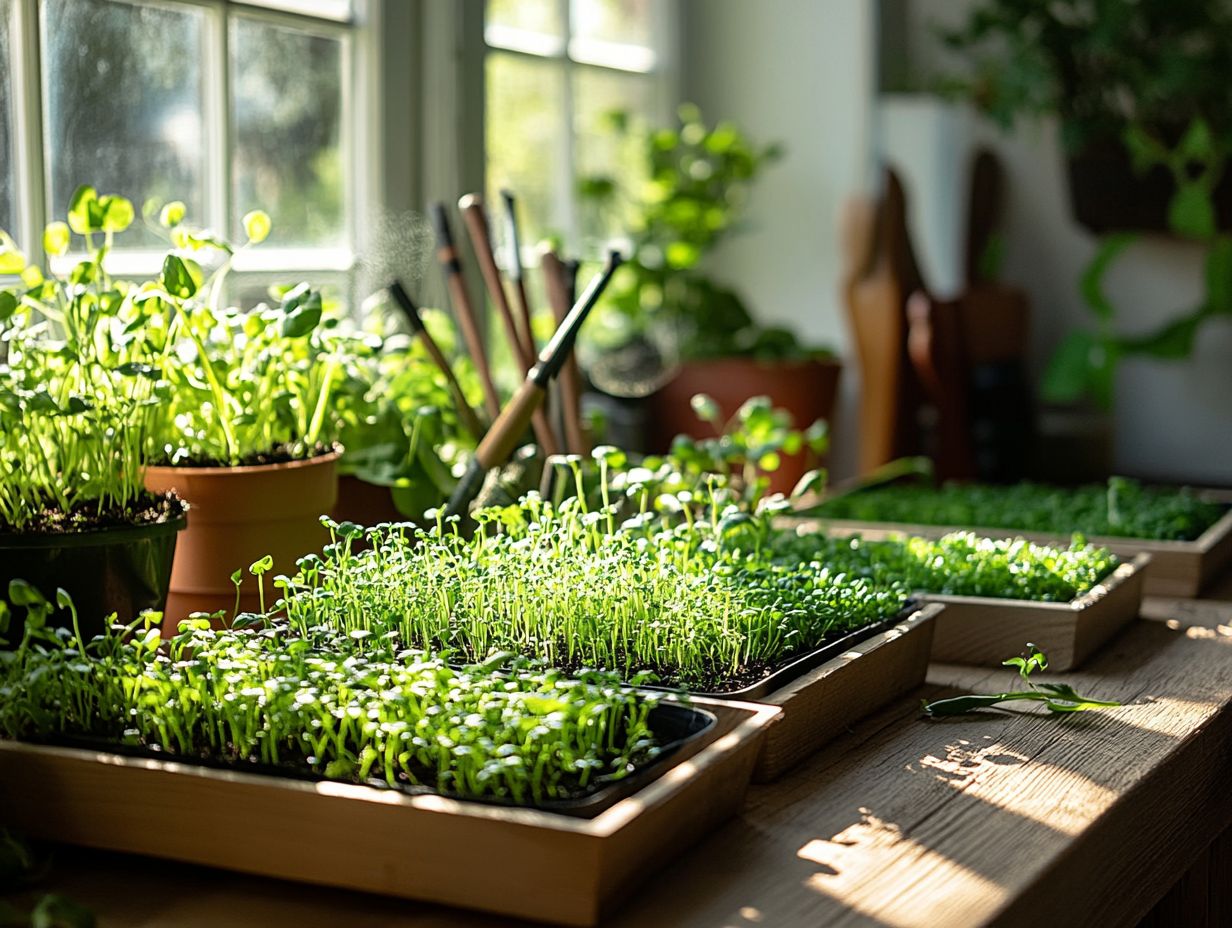
What are the five key factors for growing microgreens?
The five key factors for growing microgreens are light, water, temperature, soil, and variety selection.
How much light do microgreens need to grow successfully?
Microgreens require a lot of light to grow, ideally 12-16 hours of bright, direct sunlight or 14-18 hours of artificial light.
What is the ideal water schedule for microgreens?
Microgreens need regular watering, typically once or twice a day, to keep the soil evenly moist but not waterlogged.
What temperature range is best for microgreen growth?
The ideal temperature for microgreens is between 60-75 F (15-24 C). A slightly cooler temperature, around 65 F (18 C), is preferred for most varieties.
Why is soil important for successful microgreen growth?
Soil provides the necessary nutrients and support for microgreens to thrive. It also helps with moisture retention and aeration.
How do you choose the right variety of microgreens to grow?
The right variety of microgreens depends on personal preference and growing conditions. Research different varieties and choose ones that are well-suited for your climate and taste preferences.
Start your microgreen journey today for a burst of flavor in your meals!

